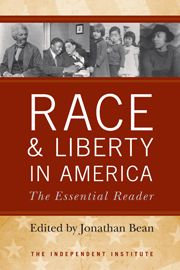The Obama presidency increasingly reminds me of the 1961 bestseller, “Black Like Me.”
The author of that classic in civil rights literature was Texas journalist John Howard Griffin, a white man who darkened his skin to pass as a black in the segregated South. By pretending to be something he was not, Griffin awakened the world to the plight of American blacks living under the racist policies of the Jim Crow South.
Sadly, President Barack Obama’s racial fixation has become disturbing in recent months. By pandering to racial pride and grievance he is betraying the liberal tradition that enabled him to become president—a tradition represented by Frederick Douglass, Branch Rickey, Zora Neale Hurston, Stanley Crouch and others who spoke out against racial injustice and defining individuals by their color.
By obsessing with racial issues, Obama makes a mockery of a tradition that sought to “get beyond” race.
The cornerstone of that tradition was the notion of a colorblind society. Indeed, as recently as 1967, the NAACP—which stirs the racial flames today—agitated for no racial identification whatsoever on any form, such as birth certificates, marriage licenses, or job or loan applications.
Zora Neale Hurston, one of the 20th century’s pre-eminent black writers, spoke for the colorblind ethic when she said, “Why should I be proud to be black? Why should anyone be proud of their skin color? Races have never done anything. All that is good and excellent is the work of individuals.” And she meant it.
By way of contrast, Obama in April pandered to black voters by making a public display of his “black-only” Census identification. The president who once said he “could not disown his white mother and grandmother” did just that.
A second foundation of the liberal tradition of racial harmony was the notion of equal justice for all.
The NAACP’s founder, a white man—Moorfield Storey—would cringe at the president and NAACP today.
The NAACP’s McCarthyist name-calling and “guilt by association,” directed at members of the so-called Tea Party movement, together with Obama’s selective outrage at injustices both at home and abroad, would strike Storey as disturbingly similar to the white supremacist principles he fought against with the NAACP.
The president and the NAACP need to remember that the civil rights movement also attracted a fringe element. Even people that many now glorify, such as Malcolm X, spewed the worst anti-Semitism and anti-white racism. The Rev. Martin Luther King was accused of accepting the help of communists and socialists—and individuals with such ties were indeed part of the civil rights “movement,” because in a free country everyone has the right to petition the government for redress of grievance.
More disturbing than the NAACP’s political posturing is the president’s one-sided view of justice. What kind of signal does it send to the country when the Department of Justice refuses to prosecute members of the New Black Panther Party for intimidating whites at a polling place? Justice is supposed to be color blind, not wear blinders.
Obama originally grabbed the imagination of the American people after a speech, now reprinted in countless books, speaking of biracialism and a desire to transcend race. A small cottage industry of books emerged describing the shift to “post-racial politics.” That was then, this is now.
His popularity plummeting, Obama now turns inward into his “blackness” and turns the other way as his supporters project all opposition to his party and policies as racist. This is wrong.
The president needs to remember his own bi-racial roots and remind his administration and supporters that criticism is not the same as hate. He also needs to re-read the classics of civil rights literature; Frederick Douglass could teach him a thing or two, as could the earlier figures of the NAACP.
A race-obsessed Mr. Hyde appears to be living within Obama’s Dr. Jekyll at 1600 Pennsylvania Ave. The president needs to be rid of him.









